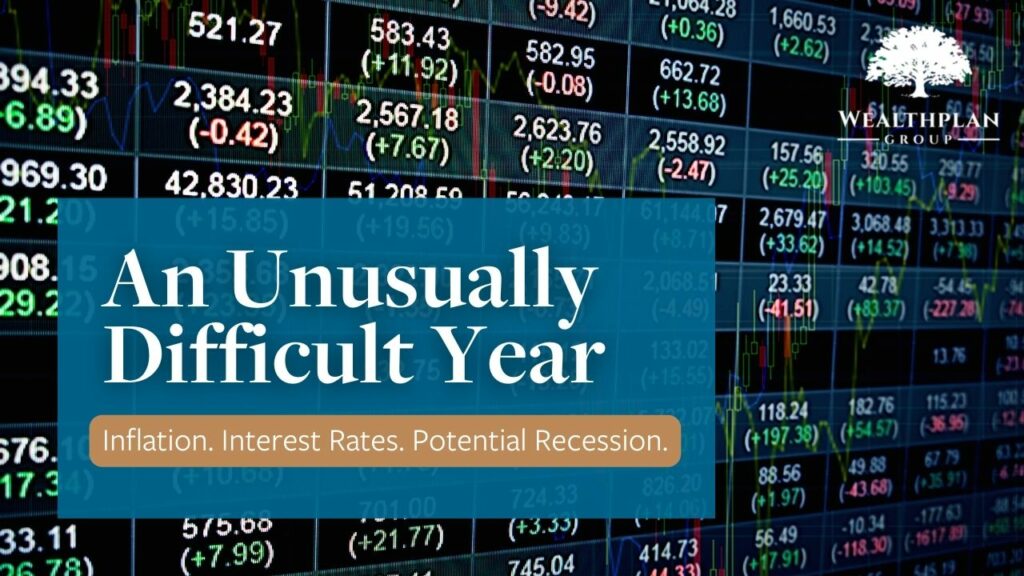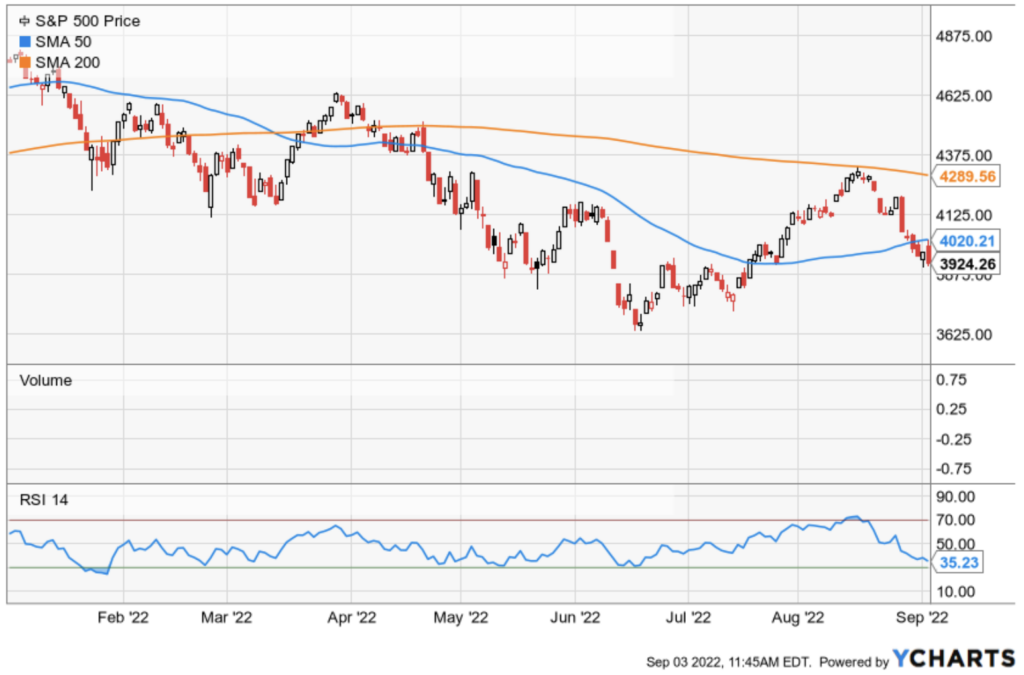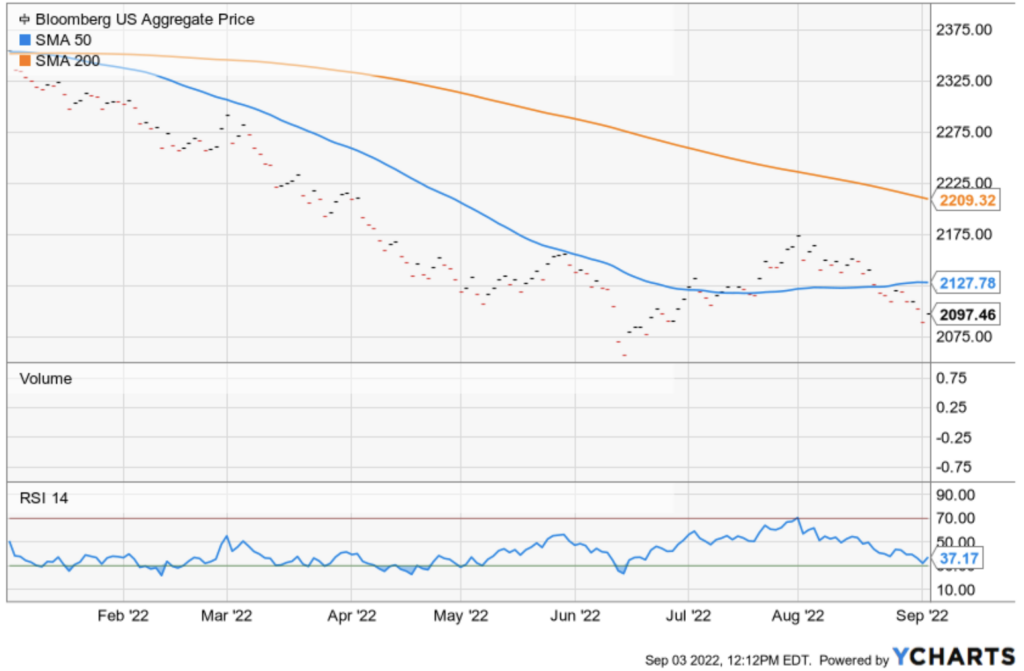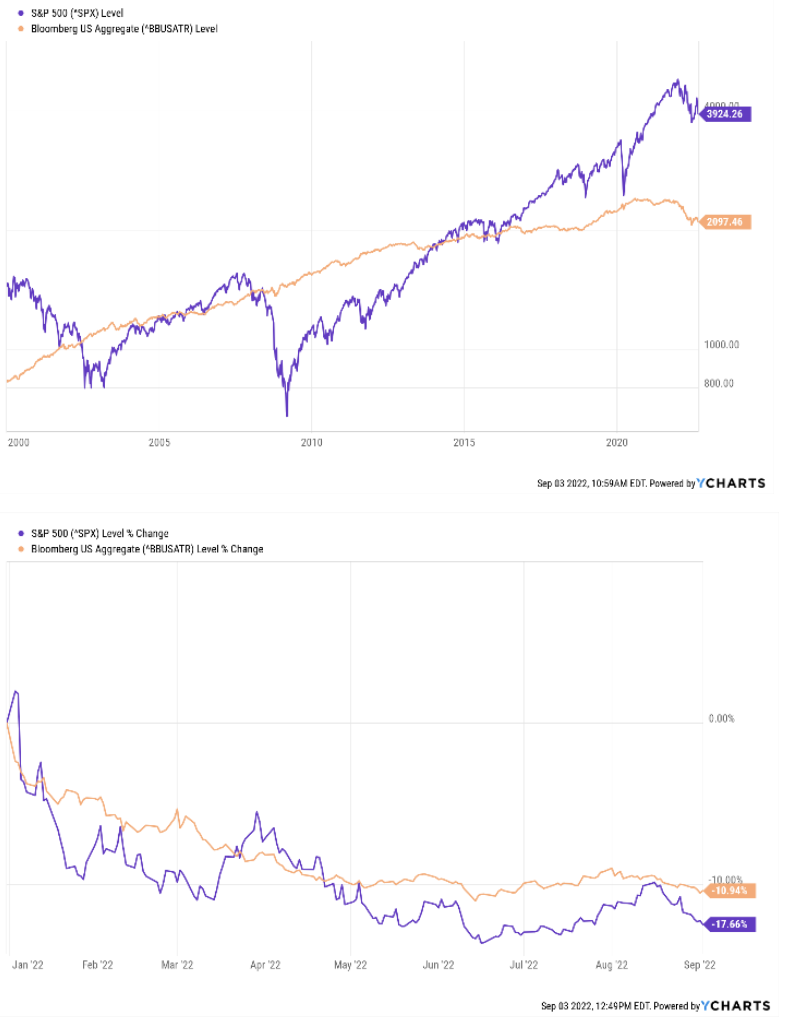An Unusually Difficult Year

Market Commentary, September 6, 2022
We are all aware of the headlines. Record Inflation. Rising Interest Rates. Potential Recession. Against these headlines we have some conflicting data.
For example, corporate earnings remain strong and Wall Street analysts remain optimistic in their earnings forecasts. Analysts are still calling for the S&P 500 Index in aggregate to earn between $240 to $250 in 2023, placing the forward PE ratio between 16x and 17x, which is a fair (but not inexpensive) valuation. This set-up begs two questions.
- Why has it been such a difficult year for stocks?
- Why has it been such a difficult year for investors?
Here is a look at the S&P 500 Index daily returns on a year-to-date basis.

Reasons the stock market is struggling this year
The reason stocks are struggling is that we have two PRIMARY factors that, in concert, are working against stocks.
The first primary factor is valuations. Stocks began the year in a historically high valuation position, only exceeded in the dot com tech bubble of the late 1990s. The first 20% or so decline in stock prices can be thought of as simply resetting valuations to a more reasonable level. At the present, stocks are down but they’re still not cheap; they’re just reasonably priced.
The second primary factor is rising interest rates. Stocks are long duration assets and the way we figure out what their future earnings are worth is to discount those expected future earnings back to the present using prevailing interest rates. As rates have risen, the present value of future earnings drops (this is a certain mathematical relationship in stock valuation models.) If rates continue to rise, stock valuations will continue to drop. Full stop.
Reasons it has been such a hard year for investors
The primary reason it has been such a hard year for investors is that bonds have performed very poorly in lockstep with stocks; which is rare. Below is a graph of the daily returns of the Bloomberg Aggregate Bond Index year to date. One might conclude that this chart looks a lot like the preceding stock chart….and they’d be right! What might be lost on some is that the return to bonds in the chart below is on pace to be the worst year on record for bonds. EVER! How bonds finish the year will determine whether it’s their worst year ever or not, but this potential outcome is a real possibility.

This year is unusual because, in most scenarios, bonds provide a counterbalance to stocks, providing a haven when equities are under pressure. Below are two charts comparing the returns of stocks and bonds. The first is compares the returns since the year 2000 while the second zeroes in on the year-to-date experience.

In looking at the left panel, one can see that normally bonds have provided some downside protection when stocks are under pressure. But this year bonds have not provided such protection, which is the primary reason diversified investors are feeling the pain. This year has presented a “no place to hide” scenario for investors and the strategy of allocating to bonds has not worked to cushion downside returns as it has historically.
Where do we go from here?
In the short term, it really is anyone’s guess. Could we continue to see stocks under pressure and bonds losing value at the same time? It is a real possibility.
The Fed is on record saying they will raise rates aggressively and risk recession to bring inflation down. In this scenario, both stocks and bonds could continue along the same path they have been on so far this year. What remains to be seen is whether corporate earnings come through as analysts expect. If they do, the worst could be over. But if we get material earnings declines and declining forward estimates, there could be more pain in store for both stocks and bonds as the Fed raises rates. It’s a very challenging and uncertain time.
It is against this backdrop of punctuated uncertainty that WealthPlan’s “smarter portfolios” investment approach shines. We have created strategies designed to be more defensive than a typical stock portfolio and income-oriented strategies that are composed of more than just bonds.
Moreover, our Alternative investments strategy provides uncorrelated returns to stocks and bonds with the intent being greater portfolio stability. While we are not immune to the pains experienced this year, our portfolios have held up well compared to many of our peers. In the longer term, we do expect markets to regain their footing and resume their long-term upward trajectory. Until that time, we continue to remain cautious regarding the valuations we are willing to pay for risky assets as well as the types of risks we are willing to take with respect credit risks and duration risks within our bond holdings. If you have questions or concerns, please do not hesitate to contact your advisor.
The opinions voiced in this material are for general information only and are not intended to provide specific advice or recommendations for any individual. To determine which Investment(s) may be appropriate for you, consult your financial advisor prior to investing. Information is based on sources believed to be reliable, however, their accuracy or completeness cannot be guaranteed. No investment strategy can assure success or completely protect against loss, given the volatility of all securities markets. Statements of forecast and trends are for informational purposes and are not guaranteed to occur in the future. All performance referenced is historical and is no guarantee of future results. Securities investing involves risk, including loss of principal. An investor cannot invest directly in an index.
Advisory services offered through WealthPlan Investment Management, a subsidiary Registered Investment Advisor of WealthPlan Group, LLC.
